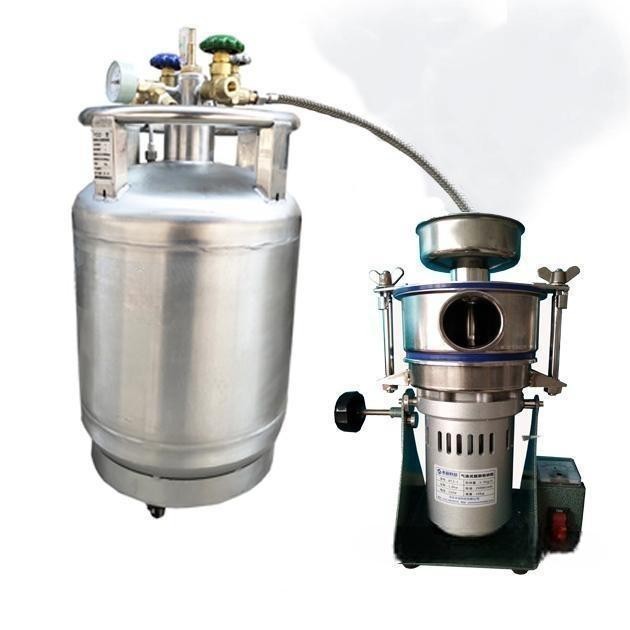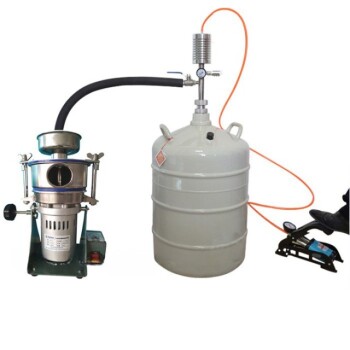
Crushing & Grinding Machine
lab cryogenic grinding use liquid-nitrogen for pulverizing plastic raw materials and heat sensitive materials
Item Number : KT-CG01
Price varies based on specs and customizations
- Cryogenic Pulverizer Fineness
- 40-300 mesh
- Capacity
- 1-3kg/h
- Power
- 1.8kw
Shipping:
Contact us to get shipping details Enjoy On-time Dispatch Guarantee.
Why Choose Us
Reliable PartnerEasy ordering process, quality products, and dedicated support for your business success.
Product Application
The Liquid Nitrogen Cryogenic Grinding Machine(Cryomilling), KT-CG01, is specifically designed for the pulverization of plastic raw materials and heat-sensitive materials in various industries. This machine is ideal for quality control, laboratory settings, and research applications where maintaining the integrity of the material is crucial. Key applications include:
- Plastics Industry: For the detection and analysis of polymers, plastics, rubber, polylactic acid, paraffin wax, PE, PP, PET, PS, PBS, TPU, and other similar materials.
- Quality Control: Ensuring the consistency and quality of materials through precise pulverization.
- Laboratory Research: Supporting scientific research by providing a reliable method for sample preparation.
- Other Industries: Widely used in traditional Chinese medicine, western medicine, pesticides, biological, cosmetic, food, feed, chemical, and ceramics industries for ultra-fine crushing of dry materials.
The KT-CG01 is particularly suited for small-scale testing, with a crushing capacity of approximately 10g, making it perfect for customers needing to test a small number of samples. It has been successfully applied in domestic quality inspection agencies, plastics industry enterprises, scientific research units, and university laboratories.
Detail & Parts

Product Feature
The KT-CG01 Liquid Nitrogen Cryogenic Grinding Machine is a cost-effective solution designed to deliver high-quality results in a compact and efficient package. Key features include:
- High-Speed Crushing: Operates at a speed of 25000r/min, ensuring rapid and efficient pulverization.
- Advanced Knife Design: Utilizes a polygonal head knife, which is scientifically designed to improve crushing efficiency, fineness, and adaptability to various materials.
- Liquid Nitrogen Cooling: Incorporates a liquid nitrogen system (foot or self-pressurized) to maintain a low-temperature environment, crucial for preserving the properties of heat-sensitive materials.
- Continuous Discharge: Features a continuous discharge mode, enhancing operational efficiency and convenience.
- Compact Design: With dimensions of 290280480mm and a weight of 12kg, the machine is portable and easy to integrate into laboratory settings.
- Versatile Application: Capable of handling a wide range of materials, from plastics and rubber to traditional Chinese medicine and cosmetics.
Working Principle
The KT-CG01 operates on a principle that combines the deep cold of liquid nitrogen with the high-speed crushing capabilities of an ultra-micro grinding machine. Here’s how it works:
- Cooling Phase: Materials are first cooled and chilled using liquid nitrogen, which can reduce the temperature to -196°C.
- Crushing Phase: The chilled materials enter the mechanical grinding machine cavity where they are subjected to high-speed rotation via an impeller.
- Impact and Collision: The materials undergo repeated impact, collision, shearing, and friction with blades, toothed discs, and other materials, leading to pulverization.
- Classification and Collection: The pulverized material is classified by an airflow sieve classifier and collected. Materials that do not meet the fineness requirement are returned for further pulverization.
- Closed-Circuit System: The system operates in a closed-circuit circulation, ensuring energy efficiency and reduced energy consumption.
This process not only ensures ultra-fine pulverization but also maintains the chemical and physical properties of the materials, making it ideal for heat-sensitive and brittle materials.
Product Advantage
The KT-CG01 Liquid Nitrogen Cryogenic Grinding Machine offers several advantages over traditional pulverization methods:
- Preservation of Material Integrity: By using liquid nitrogen, the machine prevents thermal degradation, ensuring that the original nature and state of the material are preserved.
- Ultra-Fine Grinding: Produces particles with a fineness ranging from 40-300 mesh, or even micron-level fineness, improving particle flow and dispersion.
- Efficiency and Speed: The high-speed crushing mechanism significantly reduces production times, increasing overall efficiency and output.
- Uniform Particle Distribution: Generates ultra-fine particles within narrow distribution ranges, offering more uniform and consistent results.
- Cost-Effective: Despite its advanced features, the KT-CG01 is designed to be cost-effective, making it accessible for various industries and applications.
- Versatility: Capable of handling a wide range of materials, from plastics and rubber to biological samples and traditional Chinese medicine, making it a versatile tool in multiple fields.
In summary, the KT-CG01 Liquid Nitrogen Cryogenic Grinding Machine is a powerful and versatile tool for the pulverization of plastic raw materials and heat-sensitive materials, offering superior results with minimal thermal degradation and high efficiency.
Technical specifications
| Parameter | Specification |
|---|---|
| Name | Liquid Nitrogen Cryogenic Grinding Machine |
| Model | KT-CG01 |
| Power | 1.8kw |
| Voltage | 220V |
| Cryogenic Grinding Machine Fineness | 40-300 mesh |
| Capacity | 1-3kg/h |
| Small Capacity | 10g |
| Discharge Mode | Continuous |
| Speed | 25000r/min |
| Weight | 12kg |
| Size | 290280480mm |
| Cooling Medium | Liquid Nitrogen |
| Knife Type | Polygonal Head Knife |
| Crushing Principle | High-speed Collision |
| Discharge | No Sieve Wind Selection |
| Liquid Nitrogen System | Foot / Self-pressurized (choose one) |
FAQ
What Is A Cryogenic Grinder And How Does It Work?
What Are The Main Applications Of Cryogenic Grinders?
What Are The Advantages Of Using A Cryogenic Grinder?
Why Is Liquid Nitrogen Used In Cryogenic Grinding?
What Types Of Materials Can Be Processed Using A Cryogenic Grinder?
How Does Cryogenic Grinding Improve Material Properties?
4.8
out of
5
Exceptional quality and durability. Preserves sample integrity perfectly.
4.9
out of
5
Fast delivery and great value for money. Highly recommend!
4.7
out of
5
Technologically advanced and easy to use. A game-changer for our lab.
4.8
out of
5
Impressive performance. Uniform particle distribution every time.
4.9
out of
5
Durable and efficient. Worth every penny.
4.7
out of
5
Compact design, big impact. Perfect for our research needs.
4.8
out of
5
Ultra-fine grinding with minimal thermal degradation. Excellent!
4.9
out of
5
Speedy delivery and top-notch quality. Couldn't be happier.
4.7
out of
5
Versatile and reliable. Handles all our materials with ease.
4.8
out of
5
Highly efficient and cost-effective. A must-have for any lab.
REQUEST A QUOTE
Our professional team will reply to you within one business day. Please feel free to contact us!
Related Products

Small Cryogenic Grinder Cryomill Cryogrinder with Liquid Nitrogen for Laboratory Use
Our KINTEK Cryomilling is perfect for small runs and R&D trials. With a versatile cryogenic system, it can handle a variety of materials, including plastics, rubber, pharmaceuticals, and food grades. Plus, our specialized hydraulic laboratory crushers ensure accurate results through multiple passes, making it suitable for XRF analysis. Get finely-powdered samples with ease!

Liquid Nitrogen Cryogenic Grinder Mill Cryomill Airflow Ultrafine Pulverizer
Discover the Liquid Nitrogen Cryogenic Grinding Machine, perfect for lab use, ultra-fine pulverization, and preserving material properties. Ideal for pharmaceuticals, cosmetics, and more.

Liquid Nitrogen Cryogenic Grinder Mill Cryomill with Screw Feeder
Discover the Liquid Nitrogen Cryogenic Pulverizer with Screw Feeder, perfect for fine material processing. Ideal for plastics, rubber, and more. Boost your lab efficiency now!

Vibration Mill for Efficient Sample Preparation, Suitable for Crushing and Grinding a Variety of Materials with Analytical Precision. Supports Dry / Wet / Cryogenic Grinding and Vacuum/Inert Gas Protection.

Laboratory Grinding Mill Mortar Grinder for Sample Preparation
KT-MG200 mortar grinder can be used for mixing and homogenizing powder, suspension, paste and even viscous samples. It can help users realize the ideal operation of sample preparation with more regularization and higher repeatability.

Laboratory Micro Tissue Grinding Mill Grinder
KT-MT10 is a miniature ball mill with a compact structure design. The width and depth are only 15X21 cm, and the total weight is only 8 kg. It can be used with a minimum 0.2ml centrifuge tube or a maximum 15ml ball mill jar.

Laboratory High Throughput Tissue Grinding Mill Grinder
KT-MT is a high-quality, small, and versatile tissue grinder used for crushing, grinding, mixing, and cell wall breaking in various fields, including food, medical, and environmental protection. It is equipped with 24 or 48 2ml adapters and ball grinding tanks and is widely employed for DNA, RNA, and protein extraction.

1700℃ Controlled Atmosphere Furnace Nitrogen Inert Atmosphere Furnace
KT-17A Controlled atmosphere furnace: 1700℃ heating, vacuum sealing technology, PID temperature control, and versatile TFT smart touch screen controller for laboratory and industrial use.

Laboratory Ten-Body Horizontal Jar Mill for Lab Use
The Ten-body horizontal jar mill is for 10 ball mill pots (3000ml or less). It has frequency conversion control, rubber roller movement, and PE protective cover.

Rubber Vulcanizer Vulcanizing Machine Plate Vulcanizing Press for Lab
The Plate vulcanizing press is a kind of equipment used in the production of rubber products, mainly used for the vulcanization of rubber products. Vulcanization is a key step in rubber processing.

Small Lab Rubber Calendering Machine
Small lab rubber calendering machine is used for producing thin, continuous sheets of plastic or rubber materials. It is commonly employed in laboratories, small-scale production facilities, and prototyping environments to create films, coatings, and laminates with precise thickness and surface finish.

1400℃ Controlled Atmosphere Furnace with Nitrogen and Inert Atmosphere
Achieve precise heat treatment with KT-14A controlled atmosphere furnace. Vacuum sealed with a smart controller, it's ideal for lab and industrial use up to 1400℃.

Engineering Advanced Fine Ceramics Alumina Al2O3 Crucible With Lid Cylindrical Laboratory Crucible
Cylindrical Crucibles Cylindrical crucibles are one of the most common crucible shapes, suitable for melting and processing a wide variety of materials, and are easy to handle and clean.

Anti-Cracking Press Mold for Lab Use
The anti-cracking press mold is a specialized equipment designed for molding various shapes and sizes of film using high pressure and electric heating.
Related Articles

Cryogenic Pulverization Technology and Its Applications
Explores the process, advantages, disadvantages, and applications of cryogenic pulverization in various fields.

Understanding the Functionality of Cryogenic Cold Traps
An in-depth look at how cryogenic cold traps operate and their applications in various fields.

Understanding Cold Traps in Lyophilizers: Key Factors and Evaluation Methods
Explores the role, evaluation, and common misconceptions of cold traps in lyophilizers, emphasizing the importance of water capture efficiency.

Technologies for Extracting Active Ingredients from Plants
Review of modern and traditional methods for extracting plant active ingredients, focusing on efficiency, cost, and environmental impact.

Development and Principles of Frozen Tissue Crushers
Explore the history, classification, and principles of frozen tissue crushers, including grinding ball selection and how to choose the right crusher.

Application of Ultra-Micro Pulverization Technology in the Food Industry
Explores the benefits and applications of ultra-micro pulverization technology in enhancing food processing and nutrient absorption.

Exploring the World of Molecular Gastronomy
A deep dive into the innovative culinary techniques of molecular gastronomy, its history, and its impact on modern cuisine.

Common Sense Points for Vacuum Heat Treatment
Key considerations and practices in vacuum heat treatment processes.

How to Choose Laboratory Vacuum Pumps for Maximum Efficiency and Cost Savings
Learn how to choose the right lab vacuum pump for efficiency & cost savings. Compare oil-sealed vs. oil-free pumps & future-proof your investment.

Understanding Isostatic Pressing: Process, Benefits, Limitations, and Applications
Isostatic pressing is a manufacturing process that offers numerous benefits and applications in various industries. It involves subjecting a material to equal pressure from all directions to achieve uniform density and shape. This method is particularly advantageous compared to other production techniques.

Isostatic Pressing Technology: Revolutionizing Ceramic Material Densification
Explore how isostatic pressing techniques enhance ceramic properties, achieving 100% theoretical density and eliminating porosity.

Comprehensive Guide to Isostatic Pressing: Types, Processes, and Features(3)
Isostatic pressing is a versatile manufacturing process that is widely used in various industries. It involves subjecting a material to equal pressure from all directions to achieve uniform density and shape. Isostatic pressing offers numerous advantages, such as the ability to produce complex shapes, uniformity in material properties, and high precision.